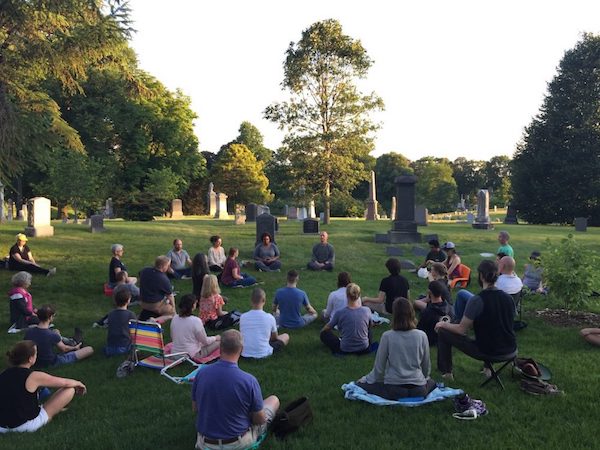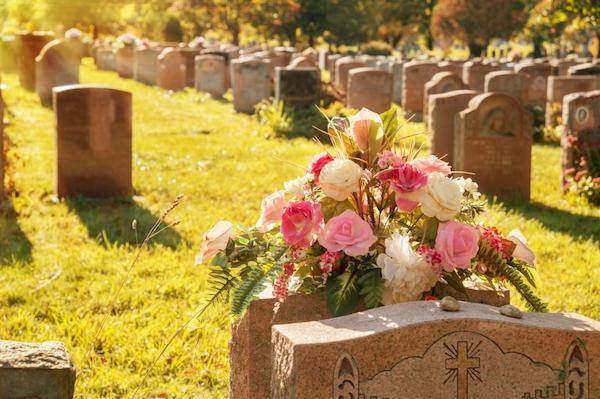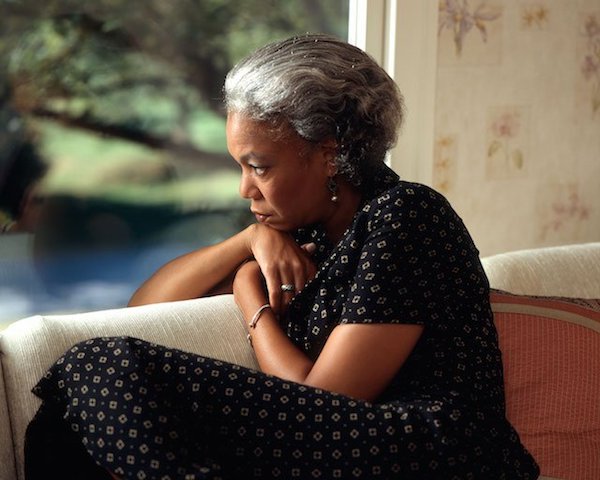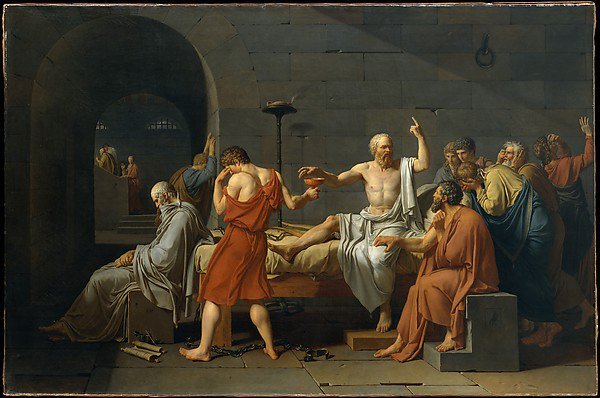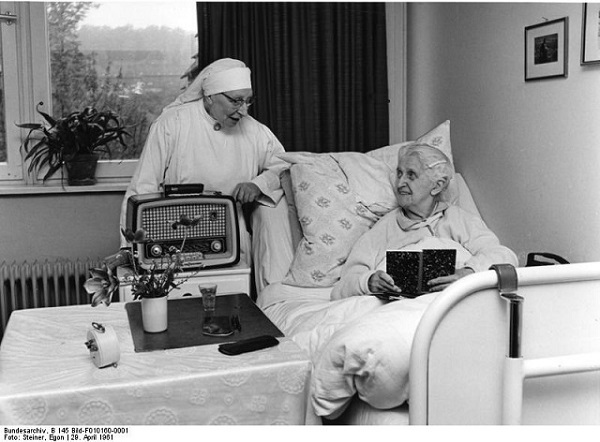Can we shift our perspective on the reality of loss?
[W]hen I arrived at the main gate of Brooklyn’s Green-Wood Cemetery, I was greeted by two talkative green birds hopping and flapping about in the grass. I was surprised; the birds seemed bright and exotic compared with the pigeons, jays, and sparrows I normally see. I later learned that these playful birds are monk parakeets—a very fitting name given that I was attending an event called Death and Dharma, a lecture and meditation series co-presented by the Brooklyn Zen Center and Green-Wood Cemetery.
Green-Wood’s high, rolling hills and shady lawns offered a cool and quiet respite from the heat and hum of downtown Brooklyn. A group of about 40 people gathered on the grass near the cemetery’s Modern Chapel, a serene space for meditating and contemplating death and dying.
“Death is a fundamental question. It’s sometimes called ‘the big question,’” said Rev. Francisco (Paco) Genkoji Lugoviña, the founder and guiding teacher at the Hudson River Peacemaker Center. “There are lots of questions, actually, and no real answers. However, at age 78, I try to live each day with as much involvement and obedience to what emerges and go with it.”
Joining Lugoviña was Rev. Daiken Nelson, the founder and guiding teacher at the Pamsula Zen Center in Harlem. Nelson and Lugoviña are both teachers and priests in the White Plum Lineage of Taizan Maezumi Roshi and the Zen Peacemaker Order. As a pair that often teaches together, they were invited to share their insights with the Brooklyn Zen Center community.
“In the West, and particularly in the U.S., people don’t deal with death until they have to,” Nelson said. “They don’t think about it until someone they know passes away. I think it’s important to at least think about it before that happens and try to realize that it’s everyone’s fate.”
While the discussion was rich with teachings, stories, and koans from the Zen tradition, Nelson and Lugoviña also created space for people to briefly talk about their own relationships with death and dying. At the start of the discussion, they asked individuals to share one or two words that reflected their thoughts on the topic. While many people expressed a cautious wonder and curiosity about the topic, others shared words like “fear,” “uncertainty,” and “dark.”
Lugoviña didn’t seem very surprised. As a Zen teacher, he said that he often ventures into this very territory, especially in his conversations with people struggling with anxiety, depression, and suicidal thoughts. He also relayed a poignant story about his grandson, who passed away at age 23 after a methadone overdose. That experience taught him to reevaluate his intellectual understanding about death and shift toward a deep experience of gratitude.
“A friend of mine once told me she that she used to count her life by the number of summers she had left,” he said. “I think that’s a very poetic way to look at what we value in our lives and cherish what’s important to us.”
In a short work titled “Vulnerability,” acclaimed poet David Whyte writes, “The only choice we have as we mature is how we inhabit our vulnerability, how we become larger and more courageous and more compassionate through our intimacy with disappearance.” Nelson echoed this by imparting a teaching about impermanence and what can come of embracing the transient nature of experience.
“What I’ve been working with in my own practice is accepting whatever is arising,” he said. “We can learn to accept our inevitable passing, the passing of others, and the passing of this moment. Realizing something is just how it is—that it’s ‘just this,’ without it having to be any different—can give rise to freedom.”
At Green-Wood, humble gravestones and elaborate mausoleums dot the landscape, crowding some of the hills and valleys. The root of the word monument is the Latin word monere, which means “to remind.” These markers remind the living of the deceased’s name, life, and family, but for Nelson, the monuments reflect a more complicated reality that attempts to honor both the teachings of impermanence and the reality of human connection and loss.
“Once we are born, we exist, and then we spend our lives going to great lengths to express that in the world,” he said. “We spend a great deal of time and energy thinking about this self, or the ideas we have about awareness, consciousness, our connections with others, acceptance, and impermanence. Then people die, and afterwards, we want to live in the memory of them, whether it’s through their accomplishments, their stories, or things we build to honor them.”
He then introduced a teaching from Bankei, a 9th century Chinese Zen master. While recovering from a serious illness as a young man, Bankei realized his existence was nothing more than a moment-by-moment experience. He framed his realization about life as “the unborn.”
“He taught us that nothing is ever born and nothing ever dies,” Nelson said. “Life is a moment-by-moment arising and falling away. So, he said, don’t get born. Don’t fall into identification as me or you, as young or old, as a woman or a man. Even our habits are not part of our original being. Everything is unborn. Why not abide in that?”
He then looked around and chuckled.
“What better place to talk about the unborn than a cemetery?”
Many of us laughed, too. Later, during meditation, I tried to focus on the sounds and sensations I was experiencing: the gentle breeze rolling off the back of my neck, the cool grass under my feet, the soft breathing of my friends around me. At one point several birds cried out, asserting their place in the world before settling in for the evening.
I began to realize that it is possible to sit in a cemetery—a place so deeply associated with death and loss—and feel very much alive. I also understood this as something I can practice on a regular basis; when I find myself sinking into mental, physical, or emotional places of decay, I can work to more directly experience my own vitality as I honor the complicated thoughts of fear and doubt swirling within me.
By the end of meditation, the sun had dipped below the Upper New York Bay. In the lingering warmth of the afternoon, I found myself wondering how many more summers I have left. In that same moment, however, I was able to shift my perspective and realize: I am here, right now, breath-filled and conscious and capable of so much. As my friends and I walked out of the cemetery, I took comfort in their singsong voices echoing in the open twilight sky. I also noticed a pigeon’s glowing red feet, the cemetery security guard’s half-smile, and the first fireflies brave enough to shine their lanterns and welcome the night.
Complete Article HERE!

